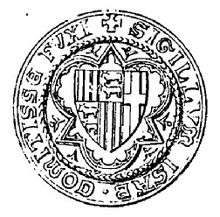Isabella, Countess of Foix
| Isabella | |
|---|---|
| suo jure Countess of Foix | |
 Seal of Isabella | |
| Reign | 1399-1428 |
| Spouse(s) | Archambaud de Grailly |
|
Issue | |
| Noble family | Foix |
| Father | Roger Bernard V, Viscount of Castelbon |
| Mother | Gerauda of Navailles |
| Born | before 2 November 1361 |
| Died | 1428 |
| Buried | Abbey of Boulbonne |
Isabella of Foix also known as Isabella of Foix-Castelbon (before 2 November 1361-1428) was the daughter of Roger Bernard V, Viscount of Castelbon and his wife Gerauda of Navailles. She was Countess of Foix in her own right, but shared power with her husband. She succeeded as countess along with her husband upon the death of her childless brother Matthew.
Family
Isabella was the eldest of three children, her two brothers were the aforementioned Matthew and Roger Bernard, who died young. Isabella inherited since neither brothers left children.
Isabella's paternal grandparents were Roger Bernard IV, Viscount of Castelbon and his wife Constance de Luna, daughter of Artal de Luna and Constance Perez of Aragon. Roger Bernard IV was son of Gaston I of Foix and his wife Jeanne of Artois, daughter of Robert of Artois and Blanche of Brittany.
Isabella's maternal grandparents were Garcie Arnaud IV, Baron de Navailles and his wife Béarnaise de Miramont.[1]
Life
Isabella married in 1381 to Archambaud de Grailly. After the death of her younger brother Matthew in 1398, who had tried to claim the Aragonese crown for his wife Joanna; Isabella was last living member of the House of Foix and was heiress of a large ownership which focused especially on the northern slopes of the Pyrenees. This heritage was to be denied to Isabella by the French Crown because of her marriage to Archambaud, whose family had been supporters of the English during the Hundred Years' War. Charles VI of France wanted to prevent Foix from falling under influence of England, so a Royal Army under the leadership of the Constable de Sancerre invaded Foix and occupied large portions. In this situation, Isabella and her husband were willing to submit to the French Crown. The Treaty of Tarbes on 10 May 1399 saw Isabella made Countess as long as her husband stopped his alliance with the English and allow the two oldest sons of the couple to be taken to Royal Court.
The fate of the new Foix dynasty during the French feudal was reflected in its name because Isabella's descendants renounced the leadership of the name and coat of arms of Grailly in favor of the House of Foix's. The loyalty of the new Dynasty of Foix to France was awarded in 1412, when Archambaud was appointed Lieutenant-General of the Languedoc.[2] In 1402 Isabella and her husband arranged the marriage for their eldest son, John to the eldest daughter of Charles III of Navarre, Joan, who was formally recognised as heiress to the Kingdom later that year. This marriage hoped to make a union between Foix and Navarre. However, in 1413, Joan died leaving no issue and John a widower, all hope of a union had now failed.
Foix was a neighbour of the Kingdom of Aragon, the conditions were relaxed after 1400 when Martin of Aragon refunded Isabella the County of Castelbon which the King had withdrawn from her brother 1386, after he fought for the crown.
Archambaud died in 1413, Isabella died in 1428 and was buried in the Abbey of Boulbonne, the resting place of her ancestors.
Children
The couple were married for around thirty-two years, in which time they had five sons:
- John (c.1382- 4 May 1436), succeeded as John I, Count of Foix. He married three times; he had two sons by his second wife, Jeanne d'Albret (1403–1433), who was the daughter of Charles I of Albret, commander of the French forces at the Battle of Agincourt, and Marie, Dame de Sully. His third wife was Joanna of Urgell, daughter of James II of Urgell and Infanta Isabella, daughter of Peter IV of Aragon. He was an ancestor of King Henry II of France
- Gaston (died after 1455), married Margaret d'Albret, by whom he had issue; he was an ancestor of the House of Foix-Candale
- Archambaud (killed in battle 10 September 1419) [3] married Sancha de Cabrera and had a daughter, also named Isabelle
- Matthew (died December 1453), married firstly to Margaret, Countess of Comminges, had no issue; secondly to Catherine of Coarraze, by whom he had two daughters. He also fathered two illegitimate children by mistresses whose identities are unknown.
- Peter (1386- 13 December 1464), Archbishop of Arles
Ancestry
| Ancestors of Isabella, Countess of Foix | |||||||||||||||||||||||||||||||||||||||||||||||||||||||||||||||||||||||||||||||||||||||||||||||||||||||||||||||||||||||||||||||||||||||||||||||||||||||||||||||||||||||||||||||||||||||||||||||||||||||||||||||||||||||||||||||||||||||||||||||||||||||||||||||||||||||||||||||||||||||||||||||||||||||||||||||||||||||||||||||||||||||||||||||||||||||||||||||||||||||||||||||||||||||||||||
|---|---|---|---|---|---|---|---|---|---|---|---|---|---|---|---|---|---|---|---|---|---|---|---|---|---|---|---|---|---|---|---|---|---|---|---|---|---|---|---|---|---|---|---|---|---|---|---|---|---|---|---|---|---|---|---|---|---|---|---|---|---|---|---|---|---|---|---|---|---|---|---|---|---|---|---|---|---|---|---|---|---|---|---|---|---|---|---|---|---|---|---|---|---|---|---|---|---|---|---|---|---|---|---|---|---|---|---|---|---|---|---|---|---|---|---|---|---|---|---|---|---|---|---|---|---|---|---|---|---|---|---|---|---|---|---|---|---|---|---|---|---|---|---|---|---|---|---|---|---|---|---|---|---|---|---|---|---|---|---|---|---|---|---|---|---|---|---|---|---|---|---|---|---|---|---|---|---|---|---|---|---|---|---|---|---|---|---|---|---|---|---|---|---|---|---|---|---|---|---|---|---|---|---|---|---|---|---|---|---|---|---|---|---|---|---|---|---|---|---|---|---|---|---|---|---|---|---|---|---|---|---|---|---|---|---|---|---|---|---|---|---|---|---|---|---|---|---|---|---|---|---|---|---|---|---|---|---|---|---|---|---|---|---|---|---|---|---|---|---|---|---|---|---|---|---|---|---|---|---|---|---|---|---|---|---|---|---|---|---|---|---|---|---|---|---|---|---|---|---|---|---|---|---|---|---|---|---|---|---|---|---|---|---|---|---|---|---|---|---|---|---|---|---|---|---|---|---|---|---|---|---|---|---|---|---|---|---|---|---|---|---|---|---|---|---|---|---|---|---|---|---|---|---|---|---|---|---|---|---|---|---|---|---|---|---|---|---|---|---|---|---|---|---|---|---|---|---|---|---|---|---|
| |||||||||||||||||||||||||||||||||||||||||||||||||||||||||||||||||||||||||||||||||||||||||||||||||||||||||||||||||||||||||||||||||||||||||||||||||||||||||||||||||||||||||||||||||||||||||||||||||||||||||||||||||||||||||||||||||||||||||||||||||||||||||||||||||||||||||||||||||||||||||||||||||||||||||||||||||||||||||||||||||||||||||||||||||||||||||||||||||||||||||||||||||||||||||||||
References
- ↑ Cawley, Charles, TOULOUSE, Medieval Lands, Medieval Lands database, Foundation for Medieval Genealogy,
- ↑ Short Biography of Isabella of Foix
- ↑ Cawley, Charles, Medieval Lands, Medieval Lands database, Foundation for Medieval Genealogy,
| Isabella, Countess of Foix House of Foix-Castelbón Cadet branch of the House of Foix Born: bef. 2 November 1361 Died: circa 1428 | ||
| French nobility | ||
|---|---|---|
| Preceded by Matthew |
Countess of Foix Viscountess of Béarn 1398-1428 with Archambaud (1398–1412) John I (1412–1428) |
Succeeded by John I |